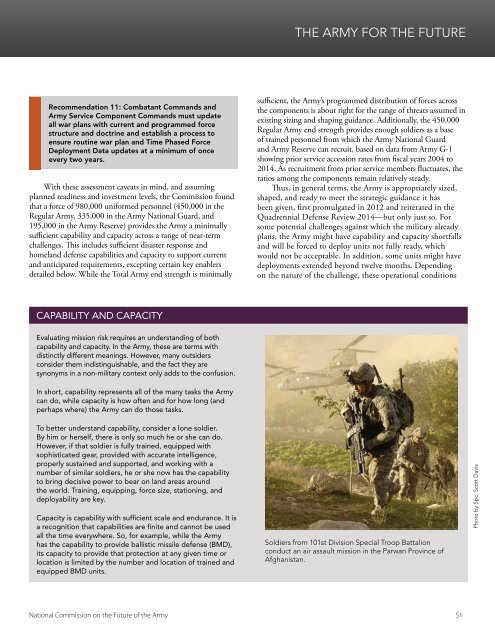THE FUTURE OF THE ARMY
Futurearmy
Futurearmy
Create successful ePaper yourself
Turn your PDF publications into a flip-book with our unique Google optimized e-Paper software.
<strong>THE</strong> <strong>ARMY</strong> FOR <strong>THE</strong> <strong>FUTURE</strong><br />
Recommendation 11: Combatant Commands and<br />
Army Service Component Commands must update<br />
all war plans with current and programmed force<br />
structure and doctrine and establish a process to<br />
ensure routine war plan and Time Phased Force<br />
Deployment Data updates at a minimum of once<br />
every two years.<br />
With these assessment caveats in mind, and assuming<br />
planned readiness and investment levels, the Commission found<br />
that a force of 980,000 uniformed personnel (450,000 in the<br />
Regular Army, 335,000 in the Army National Guard, and<br />
195,000 in the Army Reserve) provides the Army a minimally<br />
sufficient capability and capacity across a range of near-term<br />
challenges. This includes sufficient disaster response and<br />
homeland defense capabilities and capacity to support current<br />
and anticipated requirements, excepting certain key enablers<br />
detailed below. While the Total Army end strength is minimally<br />
sufficient, the Army’s programmed distribution of forces across<br />
the components is about right for the range of threats assumed in<br />
existing sizing and shaping guidance. Additionally, the 450,000<br />
Regular Army end strength provides enough soldiers as a base<br />
of trained personnel from which the Army National Guard<br />
and Army Reserve can recruit, based on data from Army G-1<br />
showing prior service accession rates from fiscal years 2004 to<br />
2014. As recruitment from prior service members fluctuates, the<br />
ratios among the components remain relatively steady.<br />
Thus, in general terms, the Army is appropriately sized,<br />
shaped, and ready to meet the strategic guidance it has<br />
been given, first promulgated in 2012 and reiterated in the<br />
Quadrennial Defense Review 2014—but only just so. For<br />
some potential challenges against which the military already<br />
plans, the Army might have capability and capacity shortfalls<br />
and will be forced to deploy units not fully ready, which<br />
would not be acceptable. In addition, some units might have<br />
deployments extended beyond twelve months. Depending<br />
on the nature of the challenge, these operational conditions<br />
CAPABILITY AND CAPACITY<br />
Evaluating mission risk requires an understanding of both<br />
capability and capacity. In the Army, these are terms with<br />
distinctly different meanings. However, many outsiders<br />
consider them indistinguishable, and the fact they are<br />
synonyms in a non-military context only adds to the confusion.<br />
In short, capability represents all of the many tasks the Army<br />
can do, while capacity is how often and for how long (and<br />
perhaps where) the Army can do those tasks.<br />
To better understand capability, consider a lone soldier.<br />
By him or herself, there is only so much he or she can do.<br />
However, if that soldier is fully trained, equipped with<br />
sophisticated gear, provided with accurate intelligence,<br />
properly sustained and supported, and working with a<br />
number of similar soldiers, he or she now has the capability<br />
to bring decisive power to bear on land areas around<br />
the world. Training, equipping, force size, stationing, and<br />
deployability are key.<br />
Capacity is capability with sufficient scale and endurance. It is<br />
a recognition that capabilities are finite and cannot be used<br />
all the time everywhere. So, for example, while the Army<br />
has the capability to provide ballistic missile defense (BMD),<br />
its capacity to provide that protection at any given time or<br />
location is limited by the number and location of trained and<br />
equipped BMD units.<br />
Soldiers from 101st Division Special Troop Battalion<br />
conduct an air assault mission in the Parwan Province of<br />
Afghanistan.<br />
Photo by Spc. Scott Davis<br />
National Commission on the Future of the Army 51


